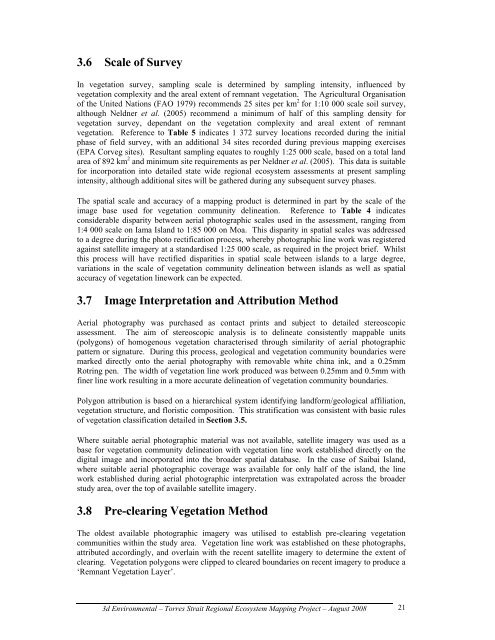Appendix 2 - Vegetation Communities and Regional Ecosystems
Appendix 2 - Vegetation Communities and Regional Ecosystems
Appendix 2 - Vegetation Communities and Regional Ecosystems
You also want an ePaper? Increase the reach of your titles
YUMPU automatically turns print PDFs into web optimized ePapers that Google loves.
3.6 Scale of Survey<br />
In vegetation survey, sampling scale is determined by sampling intensity, influenced by<br />
vegetation complexity <strong>and</strong> the areal extent of remnant vegetation. The Agricultural Organisation<br />
of the United Nations (FAO 1979) recommends 25 sites per km 2 for 1:10 000 scale soil survey,<br />
although Neldner et al. (2005) recommend a minimum of half of this sampling density for<br />
vegetation survey, dependant on the vegetation complexity <strong>and</strong> areal extent of remnant<br />
vegetation. Reference to Table 5 indicates 1 372 survey locations recorded during the initial<br />
phase of field survey, with an additional 34 sites recorded during previous mapping exercises<br />
(EPA Corveg sites). Resultant sampling equates to roughly 1:25 000 scale, based on a total l<strong>and</strong><br />
area of 892 km 2 <strong>and</strong> minimum site requirements as per Neldner et al. (2005). This data is suitable<br />
for incorporation into detailed state wide regional ecosystem assessments at present sampling<br />
intensity, although additional sites will be gathered during any subsequent survey phases.<br />
The spatial scale <strong>and</strong> accuracy of a mapping product is determined in part by the scale of the<br />
image base used for vegetation community delineation. Reference to Table 4 indicates<br />
considerable disparity between aerial photographic scales used in the assessment, ranging from<br />
1:4 000 scale on Iama Isl<strong>and</strong> to 1:85 000 on Moa. This disparity in spatial scales was addressed<br />
to a degree during the photo rectification process, whereby photographic line work was registered<br />
against satellite imagery at a st<strong>and</strong>ardised 1:25 000 scale, as required in the project brief. Whilst<br />
this process will have rectified disparities in spatial scale between isl<strong>and</strong>s to a large degree,<br />
variations in the scale of vegetation community delineation between isl<strong>and</strong>s as well as spatial<br />
accuracy of vegetation linework can be expected.<br />
3.7 Image Interpretation <strong>and</strong> Attribution Method<br />
Aerial photography was purchased as contact prints <strong>and</strong> subject to detailed stereoscopic<br />
assessment. The aim of stereoscopic analysis is to delineate consistently mappable units<br />
(polygons) of homogenous vegetation characterised through similarity of aerial photographic<br />
pattern or signature. During this process, geological <strong>and</strong> vegetation community boundaries were<br />
marked directly onto the aerial photography with removable white china ink, <strong>and</strong> a 0.25mm<br />
Rotring pen. The width of vegetation line work produced was between 0.25mm <strong>and</strong> 0.5mm with<br />
finer line work resulting in a more accurate delineation of vegetation community boundaries.<br />
Polygon attribution is based on a hierarchical system identifying l<strong>and</strong>form/geological affiliation,<br />
vegetation structure, <strong>and</strong> floristic composition. This stratification was consistent with basic rules<br />
of vegetation classification detailed in Section 3.5.<br />
Where suitable aerial photographic material was not available, satellite imagery was used as a<br />
base for vegetation community delineation with vegetation line work established directly on the<br />
digital image <strong>and</strong> incorporated into the broader spatial database. In the case of Saibai Isl<strong>and</strong>,<br />
where suitable aerial photographic coverage was available for only half of the isl<strong>and</strong>, the line<br />
work established during aerial photographic interpretation was extrapolated across the broader<br />
study area, over the top of available satellite imagery.<br />
3.8 Pre-clearing <strong>Vegetation</strong> Method<br />
The oldest available photographic imagery was utilised to establish pre-clearing vegetation<br />
communities within the study area. <strong>Vegetation</strong> line work was established on these photographs,<br />
attributed accordingly, <strong>and</strong> overlain with the recent satellite imagery to determine the extent of<br />
clearing. <strong>Vegetation</strong> polygons were clipped to cleared boundaries on recent imagery to produce a<br />
‘Remnant <strong>Vegetation</strong> Layer’.<br />
3d Environmental – Torres Strait <strong>Regional</strong> Ecosystem Mapping Project – August 2008<br />
21


